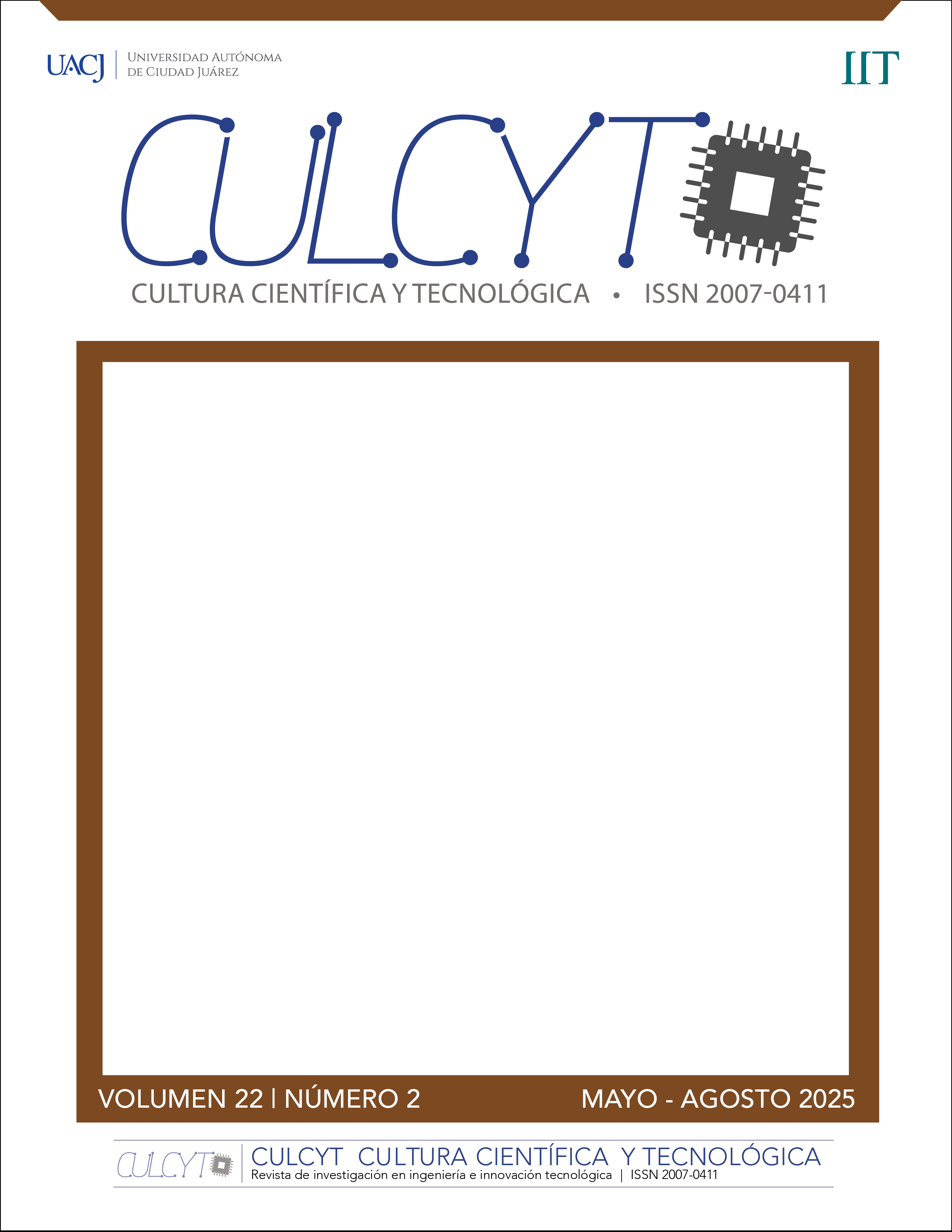Power quality study in an industry in Ciudad Juarez, Mexico
DOI:
https://doi.org/10.20983/culcyt.2025.2.2e.2Keywords:
power quality, sustainability, electrical analysis, energy efficiency, optimizationAbstract
This study aims to analyze the parameters that affect the quality of electrical energy in a maquiladora industry in Ciudad Juarez, Chihuahua, Mexico, identifying current regulations and the consequences of problems in energy quality. The methodology used includes data collection through a Fluke 1750 Power Recorder, followed by a detailed analysis of factors such as voltage, current, frequency, and harmonic distortion. The results reveal that energy quality shows significant variations that can impact the operational efficiency of the industry, as well as the lifespan of equipment. Improvement actions are proposed based on the findings, highlighting the importance of conducting periodic studies to ensure a stable power supply. This work contributes to sustainability by promoting more efficient energy use, reducing operational costs, which in turn minimizes the environmental impact of industrial operations. The implementation of the recommendations derived from the study not only optimizes energy performance but also encourages responsible practices in resource usage, aligning with sustainable development goals.
Downloads
References
X. Liang, “Emerging power quality challenges due to integration of renewable energy sources”, IEEE Trans Ind Appl, vol. 53, n.º 2, pp. 855-866, mar.-abr. 2017, doi: 10.1109/TIA.2016.2626253.
S. Ahmad, A. Iqbal, I. Ashraf y M. Meraj, “Improved power quality operation of symmetrical and asymmetrical multilevel inverter using invasive weed optimization technique”, Energy Reports, vol. 8, pp. 3323-3336, 2022, doi: 10.1016/j.egyr.2022.01.122.
Norma Oficial Mexicana NOM-001-SEDE-2012, Instalaciones Eléctricas (utilización). Ciudad de México: Gobierno de México, 2019. Accedido: sept. 24, 2023. [En línea]. Disponible en: https://www.gob.mx/cms/uploads/attachment/file/512096/NOM-001-SEDE-2012.pdf
O. H. Abdalla, S. Elmasry, M. I. El Korfolly e I. Htita, “Harmonic Analysis of an Arc Furnace Load Based on the IEEE 519-2014 Standard”, 2022 23rd International Middle East Power Systems Conference (MEPCON), El Cairo, Egipto, 2022, pp. 1-7, doi: 10.1109/MEPCON55441.2022.10021725.
E. Stano y S. Wiak, “The Accuracy of Evaluation of the Requirements of the Standards IEC 61000-3-2 (12) with the Application of the Wideband Current Transducer”, Sensors, vol. 24, n.º 11, p. 3693, 2024, doi: 10.3390/s24113693.
S. Barcón, R. G. Cepeda e I. Martínez, Calidad de la energía: factor de potencia y filtrado de armónicas. McGraw-Hill Educación, 2012.
L. A. Flores, M. D. Cossío y D. C. Salas, “Naturaleza y alcance jurídico del Código de Red, en el sistema eléctrico mexicano”, EDUTEC, vol. 26, n.º 27, pp. 101-121, 2020, doi: 10.58299/edu.v26i27.263.
Resolución RES/550/2021 de la Comisión Reguladora de Energía por la que se expiden las Disposiciones Administrativas de Carácter General que contienen los criterios de eficiencia, calidad, confiabilidad, continuidad, seguridad y sustentabilidad del Sistema Eléctrico Nacional: Código de Red. Ciudad de México: Gobierno de México, 2021. Accedido: sept. 24, 2023. [En línea]. Disponible en: https://www.dof.gob.mx/nota_detalle.php?codigo=5639920&fecha=31/12/2021#gsc.tab=0
G. E. Harper, El ABC de la calidad de la energía eléctrica. Editorial Limusa, 2006.
F. García, “Economía circular en la industria de la moda: avances y valorización del PET. Análisis de la huella de carbono,” trabajo fin de grado, Universidad de Cantabria, 2020. Accedido: sept. 24, 2023. [En línea]. Disponible en: http://hdl.handle.net/10902/19160
Fluke, “Registrador Trifásico de Calidad Eléctrica Fluke 1750,” fluke.com. https://www.fluke.com/es-mx/producto/comprobacion-electrica/calidad-electrica/1750 (accedido: sept. 24, 2023).
A. E. Legarreta, J. A. Bortolin, y J. H. Figueroa “An IEC 61000-4-30 class a—Power quality monitor: Development and performance analysis”, en 11th Int. Conf. on Electrical Power Quality and Utilisation, 2011, pp. 1-6, doi: 10.1109/EPQU.2011.6128813.
Dranetz, “Power Xplorer / Power Guide / Power Visa”, dranetz.com, 2008. https://www.dranetz.com/wp-content/uploads/2014/02/PX5_PG_PV_QuickReference_RevC.pdf (accedido: oct. 23, 2024).
Norma Oficial Mexicana NOM-113-STPS-1994, Calzado de protección. Ciudad de México: Gobierno de México, 1996. Accedido: oct. 23, 2024. [En línea]. Disponible en: https://www.himfg.edu.mx/descargas/documentos/transparencia/pot/fraccion_xiv/166norma22.pdf
Proyecto de Modificación de la Norma Oficial Mexicana NOM-116-STPS-1994, Seguridad-Respiradores purificadores de aire contra partículas nocivas, para quedar como PROY-NOM-116-STPS-2009, Respiradores purificadores de aire de presión negativa contra partículas nocivas-Especificaciones y métodos de prueba. Ciudad de México: Gobierno de México, 2009. Accedido: oct. 23, 2024. [En línea]. Disponible en: https://dof.gob.mx/nota_detalle_popup.php?codigo=5110840
Norma Oficial Mexicana NOM-115-STPS-1994, Cascos de protección-Especificaciones, métodos de prueba y clasificación. Ciudad de México: Gobierno de México, 1996. Accedido: oct. 23, 2004. [En línea]. Disponible en: http://legismex.mty.itesm.mx/normas/stps/stps115.pdf
Norma Oficial Mexicana NOM-017-STPS-2008, Equipo de protección personal-Selección, uso y manejo en los centros de trabajo. Ciudad de México: Gobierno de México, 2008. Accedido: oct. 23, 2024. [En línea]. Disponible en: https://www.stps.gob.mx/bp/secciones/dgsst/normatividad/normas/nom-017.pdf
Downloads
Published
How to Cite
Issue
Section
License
Copyright (c) 2025 Luis Edwin López López, Francisco Javier Enríquez Aguilera, Abel Eduardo Quezada Carreón, David García Chaparro, Jesús Martin Silva Aceves

This work is licensed under a Creative Commons Attribution-NonCommercial 4.0 International License.
Todos los contenidos de CULCYT se distribuyen bajo una licencia de uso y distribución “Creative Commons Reconocimiento-No Comercial 4.0 Internacional” (CC-BY-NC). Puede consultar desde aquí la versión informativa de la licencia.
Los autores/as que soliciten publicar en esta revista, aceptan los términos siguientes: a) los/las autores/as conservarán sus derechos de autor y garantizarán a la revista el derecho de primera publicación de su obra; y b) se permite y recomienda a los/las autores/as agregar enlaces de sus artículos en CULCYT en la página web de su institución o en la personal, debido a que ello puede generar intercambios interesantes y aumentar las citas de su obra publicada.



